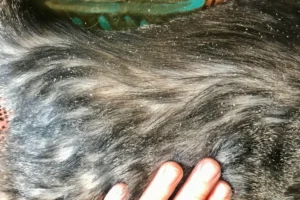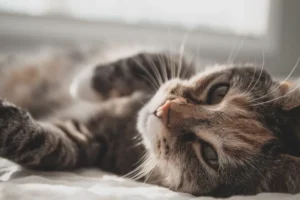Is your precious feline friend sporting dandruff near their tail? Do not fret – we’ve got you covered. Let’s unravel the mystery behind why your cat has dandruff in this informative blog post.
It’s common for cats to develop dandruff near their tail due to dry skin, poor grooming habits, diet deficiencies, or underlying health issues. Identifying the root cause is key to helping your furry companion.
Understanding Dandruff in Cats
Dandruff in cats, also known as seborrhea, is a common skin condition characterized by the flaking of dead skin cells. It often appears as white or grey flakes near the tail or along the back of your feline friend. This can be caused by various factors such as dry skin, allergies, poor diet, or even underlying health issues.
Symptoms of dandruff in cats may include itchiness, redness, and inflammation of the skin. It’s essential to monitor your cat’s skin condition regularly to catch any changes early on. If you notice persistent dandruff or other concerning symptoms, it’s best to consult your veterinarian for a proper diagnosis and treatment plan.
Regular grooming practices play a crucial role in preventing and managing dandruff in cats. Brushing your cat regularly helps to remove dead skin cells and distribute natural oils, promoting healthy skin and a shiny coat. Additionally, bathing your cat with a gentle, cat-friendly shampoo can help alleviate dandruff and keep their skin clean and hydrated.
Proper nutrition is also important for maintaining your cat’s skin health. Ensure they are receiving a balanced diet rich in essential fatty acids, which help support skin hydration and reduce inflammation. Supplementing with Omega-3 fatty acids can be beneficial for cats with dry skin and dandruff issues.
To keep your cat’s skin healthy and dandruff-free, provide a comfortable and stress-free environment. Stress can exacerbate skin conditions in cats, so make sure your feline friend has a cozy place to relax and plenty of opportunities for mental and physical stimulation.
By understanding the causes of dandruff in cats and implementing regular grooming practices and proper nutrition, you can help manage and prevent dandruff near your cat’s tail effectively.
Additional Tip: Ensure your cat is adequately hydrated by providing fresh water daily to support their skin health.
Grooming Practices for Cats
Grooming plays a significant role in maintaining your cat’s skin health and preventing dandruff issues. Regular grooming not only helps keep their coat shiny and tangle-free but also promotes better skin condition.
Brushing your cat is an essential grooming practice that can help prevent dandruff near their tail. It removes dead skin cells, distributes natural oils, and stimulates blood flow to the skin, promoting overall skin health. Using a soft-bristle brush is recommended, especially for cats with sensitive skin.
In addition to brushing, bathing your cat occasionally can help remove excess oils and dirt that may contribute to dandruff. When bathing your cat, use a mild, cat-friendly shampoo and ensure they are thoroughly rinsed to prevent skin irritation.
Trimming your cat’s nails regularly is also essential for their skin health. Overgrown nails can cause discomfort and skin irritation, leading to excessive scratching and potential skin issues. Invest in a quality nail trimmer designed for cats and establish a routine for nail maintenance.
Regular vet check-ups are crucial for monitoring your cat’s overall health, including their skin condition. Your vet can provide guidance on grooming practices specific to your cat’s needs and recommend any additional supplements or treatments if necessary.
By incorporating regular grooming practices into your cat’s routine, you can help prevent dandruff near their tail and promote healthy skin and coat. Remember that grooming is not only beneficial for your cat’s physical health but also strengthens your bond with them through care and attention.
Dietary Factors Impacting Cat Skin Health
Does your cat have dandruff near his tail? It might be due to their diet. Essential fatty acids play a crucial role in maintaining healthy skin in cats. Ensure your feline friend’s diet is rich in Omega-3 and Omega-6 fatty acids, which can promote a shiny coat and healthy skin. Consider incorporating fish oils or supplements specifically designed for skin and coat health into their meals. Always consult with your veterinarian before making any significant changes to your cat’s diet.
Additionally, hydration is key for skin health. Make sure your cat has access to fresh, clean water at all times. Dehydration can lead to dry, flaky skin. Providing wet food can also help increase your cat’s water intake. Proper hydration can help improve your cat’s skin condition and reduce dandruff near the tail.
Common Health Conditions Leading to Dandruff
If your cat is experiencing dandruff near their tail, it could be a sign of an underlying health issue. Flea allergies, dermatitis, or fungal infections can all cause dandruff in cats. Schedule a visit to your veterinarian to rule out any medical conditions that may be contributing to your cat’s dandruff.
Another common culprit for dandruff in cats is overgrooming. Cats may develop dandruff if they are excessively grooming themselves, leading to dry skin. Environmental factors such as dry air or chemical irritants in grooming products could also be affecting your cat’s skin health. Keep an eye on your cat’s grooming habits and make sure they have a stress-free environment to prevent overgrooming.
Remember, any changes in your cat’s skin condition should be addressed promptly by a veterinary professional to ensure your furry friend receives the appropriate care. Stay proactive about your cat’s health to keep them happy and comfortable.
Environmental Factors Affecting Cat Skin
If you’re wondering why your cat has dandruff near his tail, environmental factors could be at play. Dry air or lack of humidity in your home can strip your feline friend’s skin of essential moisture, leading to dry, flaky skin. Just like how our skin can get dry in certain conditions, the same goes for cats.
To help combat this issue, consider investing in a humidifier to add moisture to the air. This can help prevent your cat’s skin from becoming overly dry and flaky. Additionally, make sure your cat has access to plenty of fresh water to stay hydrated, as this can also impact their skin health.
Maintaining a consistent grooming routine can also help keep your cat’s skin in top shape. Regular brushing can help distribute natural oils throughout their fur, preventing dandruff from forming near the tail. So, if you notice your cat’s skin looking a bit flaky, consider how the environment could be affecting their skin health.
Remedies and Treatments for Cat Dandruff
When it comes to treating your cat’s dandruff near their tail, there are several remedies and treatments you can try to promote healthier skin and coat. One option is to add a omega-3 fatty acid supplement to your cat’s diet. These supplements can help improve skin health and reduce dandruff.
Another remedy is to bathe your cat with a specially formulated moisturizing shampoo. Be sure to choose a gentle, cat-friendly shampoo that won’t irritate their skin. Bathing your cat regularly can help remove excess flakes and soothe dry, itchy skin.
Regular grooming with a soft brush can also help eliminate dandruff and distribute natural oils, promoting healthier skin. Additionally, consider incorporating more moisture-rich foods into your cat’s diet, such as wet food or adding water to their kibble.
If your cat’s dandruff persists or worsens, it’s always best to consult with your veterinarian. They can provide further guidance on the best treatment options for your furry friend’s specific needs.
Pro Tip: Adding a small amount of coconut oil to your cat’s diet can also help improve skin health and reduce dandruff. Just be sure to start with a small amount and gradually increase to avoid digestive issues.
The Role of Regular Vet Check-ups
Regular veterinary check-ups are crucial for maintaining your cat’s overall health, including their skin condition. Your vet can examine your cat’s skin and coat, identifying any issues like dandruff early on. These check-ups help catch potential problems before they escalate, ensuring your furry friend stays healthy and happy.
During these visits, your vet can provide specific recommendations tailored to your cat’s needs. They may suggest dietary changes, prescribe supplements, or recommend grooming techniques to improve your cat’s skin health. By following their advice and keeping up with regular check-ups, you can address dandruff near your cat’s tail effectively.
Remember, preventative care is key to your cat’s well-being. Don’t wait for dandruff to worsen before seeking help. Stay proactive and schedule regular visits to your vet to keep your cat’s skin in top condition.
Preventative Measures for Cat Dandruff
To prevent dandruff in your cat and maintain their skin’s health, consider these proactive measures:
- Proper Nutrition: Ensure your cat is getting a balanced diet rich in essential nutrients like omega-3 fatty acids, which can promote healthy skin and coat.
- Regular Grooming: Brush your cat regularly to remove dead skin cells and distribute oils throughout their coat, preventing dryness.
- Hydration: Make sure your cat has access to fresh water at all times to maintain overall skin health.
- Humidifier: Consider using a humidifier in your home, especially during dry weather, to help prevent skin dryness in your cat.
- Consult Your Vet: If you notice persistent dandruff or skin issues, seek advice from your vet to address the underlying cause effectively.
By incorporating these preventative measures into your cat’s care routine, you can help keep their skin healthy and vibrant, reducing the likelihood of dandruff near their tail.
For more in-depth information on cat health and grooming, you can refer to the American Association of Feline Practitioners’ website: American Association of Feline Practitioners.
Fun Fact: Cats and Skin Shedding
Did you know that cats are natural skin shedders? Just like humans shed dead skin cells, cats do too. However, excessive shedding can lead to dandruff near their tail. When your cat’s skin sheds rapidly, it can accumulate and create those pesky flakes.
Purr-fect Skin Care Tips for Cats
- Regular Brushing: Brushing your cat regularly can help remove excess fur and dead skin cells, preventing dandruff buildup near the tail.
- High-Quality Diet: Ensure your cat is getting a balanced diet rich in essential nutrients to promote healthy skin and coat.
- Hydration is Key: Always provide fresh water for your cat to drink. Proper hydration is crucial for healthy skin.
- Veterinary Check-up: If your cat’s dandruff persists, consider a visit to the vet. Underlying health issues can sometimes manifest as skin problems.
By taking these steps and understanding your cat’s skin shedding process, you can help keep dandruff at bay and ensure your feline friend has a healthy and happy coat.
Alex, a passionate animal lover, has experience in training and understanding animal behavior. As a proud pet parent to two dogs and three cats, he founded AnimalReport.net to share insights from animal experts and expand his knowledge of the animal kingdom.




